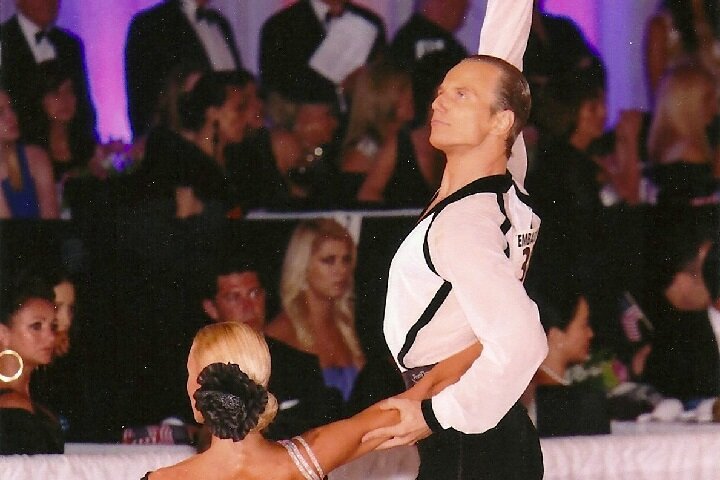Paso Doble: The Easiest Dance 
15 March 2017
In many parts of Europe, Paso Doble is learnt from the beginning along side Cha Cha and Jive. Whereas in night clubs in New York dancers might be dancing the salsa, or in Buenos Aires the Tango, in Paris people young and old alike dance the Paso Doble socially. It isn't often taught to beginner Latin Dancers in some parts of the world, which is a shame, because it is truly the easiest of the five Latin dances, even easier than Rumba. Sadly, when dancers postpone learning the Paso Doble until they reach a high level, they find they are far behind those who started earlier. Therefore, in this BGBB, I'm going to prove to you just how easy Paso Doble is, show you how you can learn this dance on your own, and challenge you to take it to the next level.
The Basics
If you are a Man, stand on your Left Foot; if you are a Lady, on your right. This is the first rule you have to learn: the Man always starts stepping with his right foot, and the Lady with her left. Now just take tiny steps in place on the ball of the foot, counting 1-2-1-2. That is Paso Doble - seriously!
Step as described above, and without moving. That is called the Sur Place.
Take tiny steps forward. That is called the Basic Movement Forward.
Take tiny steps back. That is called the Basic Movement Back.
Travel to the left, dancing side, close, side close. That is called a Chasse to the Left.
Travel to the right, dancing close, side, close, side. That is called the Chasse to the Right.
Now you've learnt five figures! What's more, any of these figures can gradually turn either to the left or the right, and if you want, you can always end the final step in Promenade Position by just turning your bodies slightly and opening up. Click on any of the figures above to see a video performance of that figure.
Walking
In addition to taking these tiny 1-2-1-2 steps, we can use regular walking steps in Paso Doble. Stand in Closed Position, and the Man will step in place with his RF, then walk forward, LF, RF, and then close LF to RF so you end with your feet together. The Lady will mirror the Man. That figure is called the Attack, and is used just to move from one place to another on the floor. What makes this different from the Basic Movement Forward is that all the steps are regular length walking steps, instead of tiny steps on the balls of the feet.
You can also walk in Promenade Position. Starting in Promenade Position, do the same thing as above, but this time with both dancers going forward. Starting in Promenade Position standing on the outside foot, the Man will step RF, LF RF, and then close his LF to his RF, turning back to face his partner squarely. The Lady will dance the natural opposite. That figure is called the Promenade Close.
The Appel
The Appel is a fun part of Paso Doble, where essentially the first step turns into a stamping of the foot on the floor in place. Because Paso Doble represents the bullfight, the Appel represents the matador's call to the bull, but in dancing, it is essentially used as a signal to the Lady which the Man uses to let her know he is about to start moving. Take the Deplacement, and turn the first step into an Appel. Now that figure is called the Attack instead of the Deplacement. It isn't really necessary that you remember the names, just that you see that all of Paso Doble is made up of just a few simple movements.
Beginner Routine
Using only the figures discussed above, try this basic routine. Just so you don't get lost counting 1.2.1.2, we'll count 1.2.3.4.5.6.7.8 below. If you'd like some Paso Doble music to dance to, check out this (Paso Doble is almost always danced to the same song).
| Figure Name | Turn | Action Used | Position | Count |
| Basic Mvt. Forward | - | Tiny steps | Closed | 1.2.3.4.5.6.7.8 |
| Basic Mvt. Back | Gradual turn to L | Tiny steps | Closed | 1.2.3.4.5.6.7.8 |
| Attack | - | Appel, then Walks | Closed | 1.2.3.4 |
| Sur Place | Turn to PP on 8 | Tiny steps | Closed, end in PP | 5.6.7.8 |
| Promenade Close | Turn to Closed on 4 | Walks | PP, end in Closed | 1.2.3.4 |
| Chasse to R | Gradual Turn to R | Tiny steps | Closed | 5.6.7.8 |
This routine isn't particularly complicated or fancy, but it is real Paso Doble! Use the other figures discussed above to make a routine of your very own.
The Next Step
All of Paso is made up of these simple steps. In terms of technique, Paso Doble is the simplest of all the dances. Visit Ballroom Guide's Paso Doble Syllabus, where all the variations of all the Syllabus figures, PreBronze through Gold, are demonstrated and described in detail. The next time a Paso Doble comes up at a social dance, try it out. If you've ever been to a social dance where a Paso Doble wasn't played, that was entirely your fault - talk to the DJ and request one, and 99% of DJ's will be happy to play one for you.
Paso Doble is a really fun dance, and it's easy to learn. Give it a try, and let me know how it goes in the comment section below!